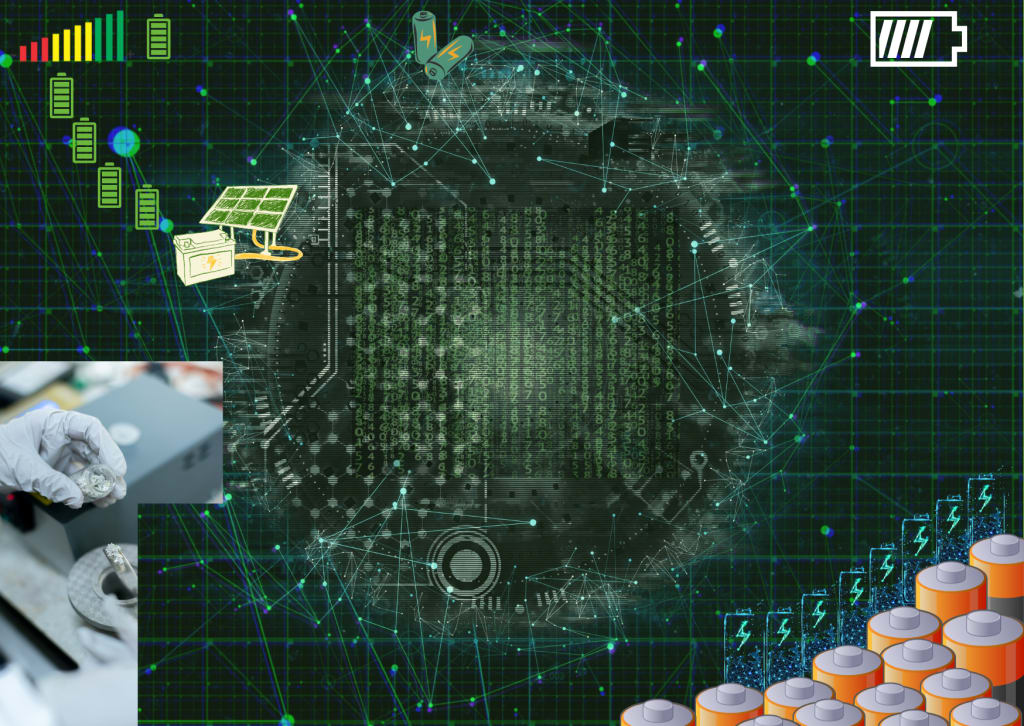
This could be the future of rechargeable batteries.
It promises more power, better security, faster charging,
and longer life.
And, in theory, it can be any shape you want.
Private companies and research labs are racing
To Decode who can one day replace them,
common lithium ions.
And a company that goes even further
and want to change our ideas
could even look like by 3D printing them.
Let's take a step back and explain what a battery is.
A typical battery works by converting chemical energy into electricity.
We need a positive end, or cathode. In this case, a galvanized nail.
And a cathode, or anode, that's our coin. We also need something to connect the two called electric charge.
This is where our potatoes come in.
Each head chemically reacts with the potato and the anode actually releases electrons that move along this wire to the cathode.
This flow of electrons is actually what converts and this chemical reaction turns into electricity.
Now that doesn't really do anything, but if we add a few more potatoes, maybe we can run a light.
Therefore, it is the basis of any chemical battery.
Lithium-ion batteries are some more successful version of this.
But there is room for improvement and startups adapt two key design elements, electrolyte and anode.
Most batteries today, pretty much any battery you'll buy,
contains liquid electrolyte. We actually call them lithium-ion batteries
because the electrolyte is filled with lithium ions.
Liquid electrolytes are excellent conductors of electricity.
But they are volatile, especially when damaged or at high temperature.
And if you watch the news, you may have seen crash reports like this.
- [Broadcast] His phone caught fire.
- [Press anchor] Model Q tartan on fire
This May have caused a fire at a local recycling plant and is something that torments these centers Nationwide.
We understood. There is a security issue.
One solution is to use materials that are more stable and non-flammable.
alternative solid materials. Currently, many companies
The construction of these solid-state batteries is being tested
with electrolytes made from all kinds of materials
such as ceramics, glass and polymers. The other big upgrade is finding a stronger material to use for your anode.
Your regular old lithium-ion battery uses graphite
which has worked quite well. But there is a stronger contender out there.
The holy grail for the anode of the battery is lithium metal.
And it's not lost on people.
Lithium metal therefore has a higher capacity than other anodes like silicon or graphite, but it is difficult to work with.
It tends to form these microscopic structures
called dendrites can short-circuit the battery.
This is a big problem for liquid electrolytes. But using solid materials can make things better.
The way I think about dendrites is like tree roots of a tree system.
Then the roots develop. You want to stop the root of, you know,
kind of come into your home. So what are you doing? You put a concrete wall or something really hard, so the mechanics stop.
So a good solid electrolyte can stand to these little thorns and still allows the flow of ions to pass easily. Over the years, There have been many improvements in these new materials. Today, top startups are looking for
to get their pilot batteries out of the lab and in a factory.
And a California-based company, Sakuu, has an even bigger swing.
They design solid-state batteries with lithium metal anode,
and they want to 3D print them. The only way to go in this direction
for a longer, safer and more premium battery is, at a given time,
challenge the production process.
So most batteries today are made with a process called roll-to-roll manufacturing. The materials are rolled out in long sheets
So most of the batteries today are produced
with a process known as roll manufacturing.
The material is spread out in the form of long sheets then scale down for individual empty layers. 3D printing, on the other hand,
maybe let Sakuu cram more layers in the same space,
improve overall battery capacity. So it's not today
where you have them in a bag and the battery is right inside, the diaper is inside, it must be sealed.
But in Sakuu Kavian-based printers,
our printing platform we can make these batteries
straight to the printer .This is how Sakuu hopes to pass
other semiconductor startups and lithium-ion manufacturers
people stick to roll-to-roll.
Then you really need the combination good battery design
and superior production technology.
Stay with roll-to-roll definitely won't let us
even have a higher energy density than anyone else.
A big warning to all of this.
Sakuu has a 3D printed solid-state battery in his lab,
but the battery is not fully printed using their prototype.
In fact, we couldn't even film 3D printer prototypes.
Sakuu says it's because there are too many.
exclusive stuff happens they are not ready
has not yet been disclosed to the public.
They actually built this prototype, they take the test,
and they try to understand how to make the best battery
using this manufacturing process. What we will show you
is actually a 3D printed model of this 3D printer.
The platform can also use some.
So it can print metal, it can print ceramics,
and it can print polymers.
And he prints them layer by layer
and this is the important aspect to make it faster.
How fast? Well, we're not sure yet. Sakuu hopes that one day all machines can produce 40 megawatt hours of energy storage per year.
Under normal conditions, it's pretty much the same 500 electric vehicle batteries per year. But this prototype works differently
compared to your regular 3D printer.
Usually a printer puts a layer of material, waits for it to solidify and then pour in the next layer. Each layer is printed and subject to quality control at the same time. Excess material can be recycled back into the system.
Layers are stacked at the end and take out a battery.
But the most surprising benefit of this process is not the power
either safety or cost. It's really a matter of form factor.
Look at these stacks. They are mostly rectangular or cylindrical.
This is because it is difficult to use one roller after another
to create different shapes. This will require new tools, more waste,
and possibly a higher price.3D printing can be much more flexible.
This is the future, you'll see the battery actually become a part,
An integral part of a product. For example, if you are viewing AR/VR glasses, The glass temple can be pin printed.
Or you look at a cell phone case can be cell phone case
actually a battery. Then the drum itself is not only stronger.
It can also fill dead space, maximize its footprint in a product,
and increase potency that way too. You don't have to design a product
around a battery. You can design the battery around your product.
And it's clearly not the real printer. So what is the footprint of one of them? For this first,
The footprint is about 10 meters long.
This is our first prototype, right? Total innovation is obviously risky.
The company claims that their process can reduce production costs,
but they will not share the real price of the printer with us.
In addition, you introduce a new manufacturing process
for an established industry, And it's always a challenge.
And they're not the only ones taking this approach.
Other companies like Blackstone Resources
and Photocentric are also working on 3D printed batteries. While all this R&D was going on, Lithium-ion batteries are getting cheaper and cheaper and stronger. It's really hard to compete.
Sakuu is building his first factory and hopes to send battery samples to customers in 2023.
This setting will therefore only store manufacture our own batteries,
is of course necessary to demonstrate the process
to show everyone that our technology works.
While startups like Sakuu are testing their first generation products,
The demand for more advanced batteries is only increasing. The goal is not only to get a better battery in your phone, it's to increase autonomy for electric vehicles and large-scale storage for a carbon-free energy grid. But to conquer the lithium-ion world,
The newbie couldn't be a little better. What do we mean?
For this material to be commercial We have to make them perfect.
Because if it's not perfect, they have become a significant challenge
when it comes to trying to make a battery out of it that will stand the test of time and power all the things we want to power.





Comments
There are no comments for this story
Be the first to respond and start the conversation.